Helping math teachers bring statistics to life


Tests About a Proportion Day 2 ( Topic 6.6 )
Chapter 9 - day 4, learning targets.
Perform a significance test about a population proportion (4-step)
Activity: Can You Taste the Rainbow?

Answer Key:
Stats medic / skew the script collaboration lesson: flint water crisis, population data:, for tips on teaching this stats medic/skew the script lesson, go here..
There has been a lot of debate recently about whether or not different colors of Skittles actually taste different . We decided to try and find the truth by doing an experiment. Students were blindfolded and asked to identify the color of Skittles based only on their taste. We then performed a significance test to assess whether or not we had convincing evidence that students can taste the rainbow. Help students to understand that the null hypothesis is p = 0.20. This is the proportion of correct identifications we would get by simply guessing (remember there are 5 flavors).
We have students work in pairs (one taster and one recorder) and have each student try 5 Skittles. The recorder simply records trials as correct or incorrect. We tell the recorder they should not tell the taster whether they are right or wrong for each trial, because we don't want tasters learning during the study. Each student records their number of correct identifications on the white board. We aggregate the data for the whole class and use the class data to perform a significance test.

The Four-Step Process
This structure was developed specifically to develop student inferential thinking, but it’s also no coincidence that it matches closely with the four-point rubrics for the free response questions on the AP Exam. This structure will be used for all inference problems for the remainder of the course, so it is critical that students become familiar with the expectations.
Tips for Using the Four-Step Process
Maintain high expectations for what students should be producing. Clearly communicate these expectations and hold them accountable when grading.
Establish patterns of thinking that will help students later. For example, always have students write a general formula first, followed by the specific formula, followed by numbers plugged in, and then a final answer. We maintain this expectation for all confidence intervals and significance tests in Chapters 8-12.
While it is important that students know how to check each condition, it is equally important that they understand why we check the condition. We call this the “so what?”.
Random Condition: so we can generalize to the population.
10% Condition: so sampling without replacement is OK.
Large Counts/Normal Condition: so the sampling distribution of the sample proportions will be approximately Normal and we can use z to find a P-value.
Don’t reveal calculator commands yet. Of course, all the work of today’s lesson can be done with 1-PropZTest on the TI 83/84 calculator. It is important that students become very familiar with the formulas and process for performing a significance test. At the end of the chapter we will reveal the calculator commands for significance tests. Then we instruct students that they are to use this feature only to check their final answer on a Free Response question (or on a MC question if they wish).
4-Step White Board Critique
We used the Check Your Understanding to do a White Board Critique. Here is how it works:
Assign students a 4-step problem to work on in pairs.
Monitor the room to support student learning. As each pair finishes, send them to the white board to write up 1 of the steps STATE, PLAN, DO, or CONCLUDE. The first two pairs should handle the PLAN and the DO because they take the longest to write up.
Once all 4 steps are on the board, call the class back together as a group. Ask them to critique the solution on the board as if it were a quiz or test question. Make any revisions with a red marker. This is your opportunity to make clear your expectations for a 4-step problem on an assessment.
Luke's Lesson Notes
Here is a brief video highlighting some key information to help you prepare to teach this lesson.
Teach yourself statistics
Statistics Problems
One of the best ways to learn statistics is to solve practice problems. These problems test your understanding of statistics terminology and your ability to solve common statistics problems. Each problem includes a step-by-step explanation of the solution.
- Use the dropdown boxes to describe the type of problem you want to work on.
- click the Submit button to see problems and solutions.
Main topic:
Problem description:
In one state, 52% of the voters are Republicans, and 48% are Democrats. In a second state, 47% of the voters are Republicans, and 53% are Democrats. Suppose a simple random sample of 100 voters are surveyed from each state.
What is the probability that the survey will show a greater percentage of Republican voters in the second state than in the first state?
The correct answer is C. For this analysis, let P 1 = the proportion of Republican voters in the first state, P 2 = the proportion of Republican voters in the second state, p 1 = the proportion of Republican voters in the sample from the first state, and p 2 = the proportion of Republican voters in the sample from the second state. The number of voters sampled from the first state (n 1 ) = 100, and the number of voters sampled from the second state (n 2 ) = 100.
The solution involves four steps.
- Make sure the sample size is big enough to model differences with a normal population. Because n 1 P 1 = 100 * 0.52 = 52, n 1 (1 - P 1 ) = 100 * 0.48 = 48, n 2 P 2 = 100 * 0.47 = 47, and n 2 (1 - P 2 ) = 100 * 0.53 = 53 are each greater than 10, the sample size is large enough.
- Find the mean of the difference in sample proportions: E(p 1 - p 2 ) = P 1 - P 2 = 0.52 - 0.47 = 0.05.
σ d = sqrt{ [ P1( 1 - P 1 ) / n 1 ] + [ P 2 (1 - P 2 ) / n 2 ] }
σ d = sqrt{ [ (0.52)(0.48) / 100 ] + [ (0.47)(0.53) / 100 ] }
σ d = sqrt (0.002496 + 0.002491) = sqrt(0.004987) = 0.0706
z p 1 - p 2 = (x - μ p 1 - p 2 ) / σ d = (0 - 0.05)/0.0706 = -0.7082
Using Stat Trek's Normal Distribution Calculator , we find that the probability of a z-score being -0.7082 or less is 0.24.
Therefore, the probability that the survey will show a greater percentage of Republican voters in the second state than in the first state is 0.24.
See also: Difference Between Proportions

Purposeful Practice
Task teacher guide.
Be sure to read the teacher guide prior to running the task. When you’re ready to run the task, use the tabs at the top of the page to navigate through the lesson.
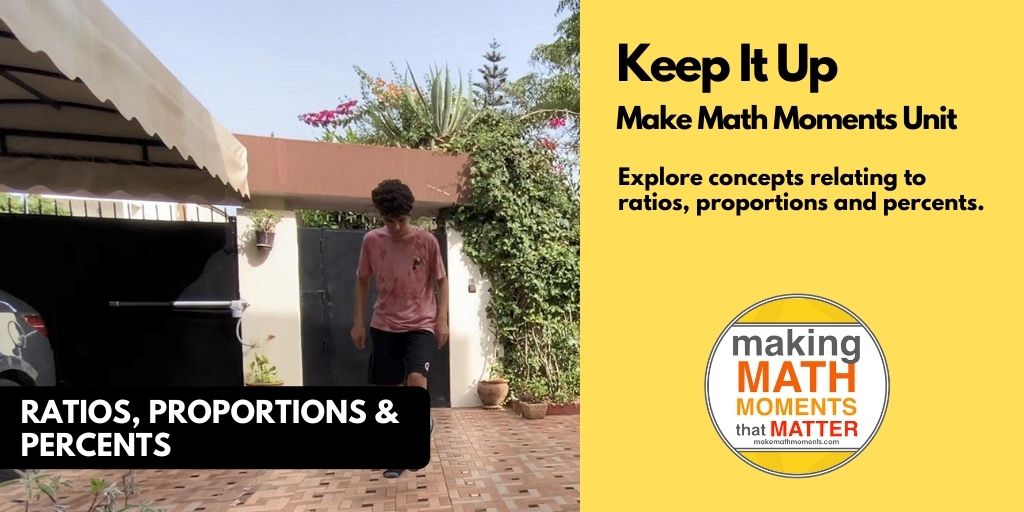
In This Task…
Students will reinforce concepts related to ratios and to explore how quantities covary by finding equivalent ratios through scaling in tandem.
Intentionality…
The purpose of Day 2 activities is to reinforce concepts from Day 1. Students will engage in a visual number talk that will encourage them to consider different ways to describe relationships between quantities and reinforce the idea of scaling in tandem to reveal equivalent ratios.
Students will also have an opportunity to complete purposeful practice that will serve to develop a deeper understanding of the following big ideas:
- A ratio is a multiplicative comparison between two or more quantities;
- There are two types of ratios; a composed unit ratio and a multiplicative comparison ratio;
- A composed unit is often (not always) a ratio with two distinct units;
- Unknown quantities in a ratio relationship are often most efficiently revealed through multiplicative thinking strategies rather than additive thinking strategies;
- A composed unit ratio can be scaled in tandem;
- Ratios can be constructed by comparing a part to its whole (part-to-whole) or comparing a part to another part of the whole (part-to-part).
- Ratios can be represented using the separator “to” or a colon “:”. Two quantities from a ratio relationship can also be represented as a quotient through the use of the division symbol “÷” or with the fraction bar.
- When you divide two quantities in a composed unit ratio through partitive division, you reveal a rate.
- Equivalent ratios are derived from the same rate;
- An infinite number of equivalent ratios can be revealed to assist in determining an unknown quantity from a ratio relationship; and,
- Ratio problems can be represented and solved using a variety of strategies, tools, and representations.
What You’ll Need…
A variety of tools for students to use to think through the problems, including, but not limited to:
- Linking cubes, Omnifix cubes or tiles
- Cuisenaire rods
- Whiteboards & markers
Visual Math Talk
String of related problems.
The following visual math talk is a string of related problems that are crafted in a way to foster discussion and the construction of viable arguments. As such, they are open ended and have more than one possible response.
As the facilitator of the following visual math talk prompts, be prepared to notice and name the thinking students are using (i.e.: additive thinking or multiplicative thinking).
While you could simply share the first image with the prompt for students, introducing via the silent solution animations provided may be more helpful. Although each visual math talk prompt video models a possible strategy, we encourage you to represent student thinking by drawing on the board or on the screen rather than simply playing the video and ignoring the thinking of your students.
Visual Math Talk Prompt #1
Consider utilizing the following visual math talk prompt and be prepared to pause where indicated:
What do you notice? What do you wonder?
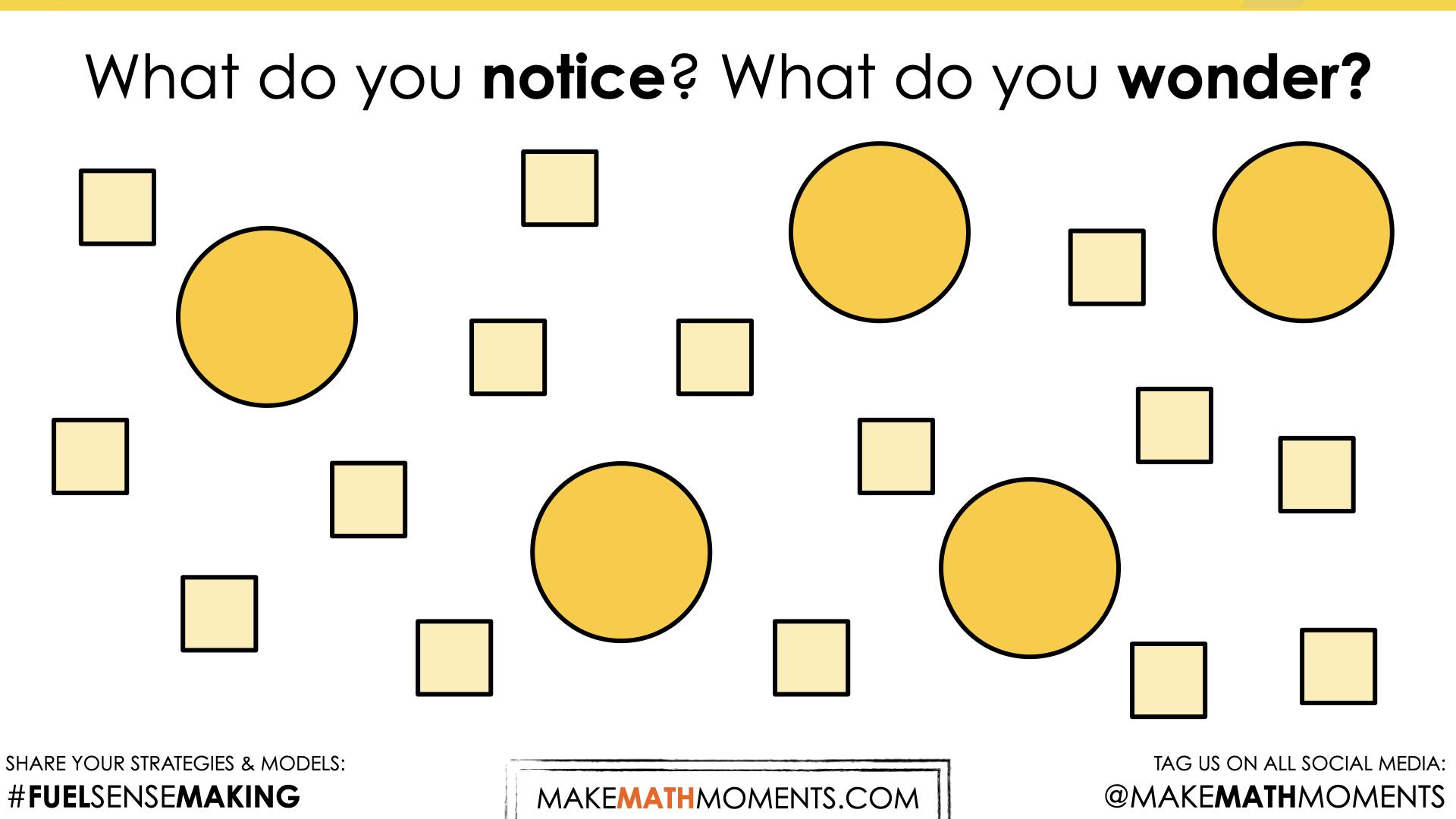
After students share some of what they notice and wonder about the shapes that have ‘popped’ on the screen, continue playing the video until the next prompt appears:
Describe as many relationships as you can between the circles and the squares.
Some possible relationships students might share include:
- There are 10 more squares than circles
- There are 3 times as many squares as there are circles
- For every circle there are 3 triangles
- \(\frac{3}{4}\) the shapes are squares (\(\frac{1}{4}\) of the shapes are circles)
- 75% of the shapes are squares
It is worthwhile to note the observations that students will share, as a way of determining if students are thinking in absolute or relative terms, and whether they are able to consider both part:whole and part:part relationships.
As you are making note of students’ observations, consider modeling the use of ratio language and notation, including:
- The ratio of ____ to ____ is _____ : ______. For example, “the ratio of squares to circles is 3:1 or the ratio of circles to squares is 1:3”.
- For every ______, there are ______.
Some students may make use of rate language such as:
- There is a rate of _____ per _____
- For example, “there is a rate of 3 squares per circle” or “there is a rate of 1 third circles per square”.
Of course, these are just some possible observations and many more ideas may be highlighted by your students.
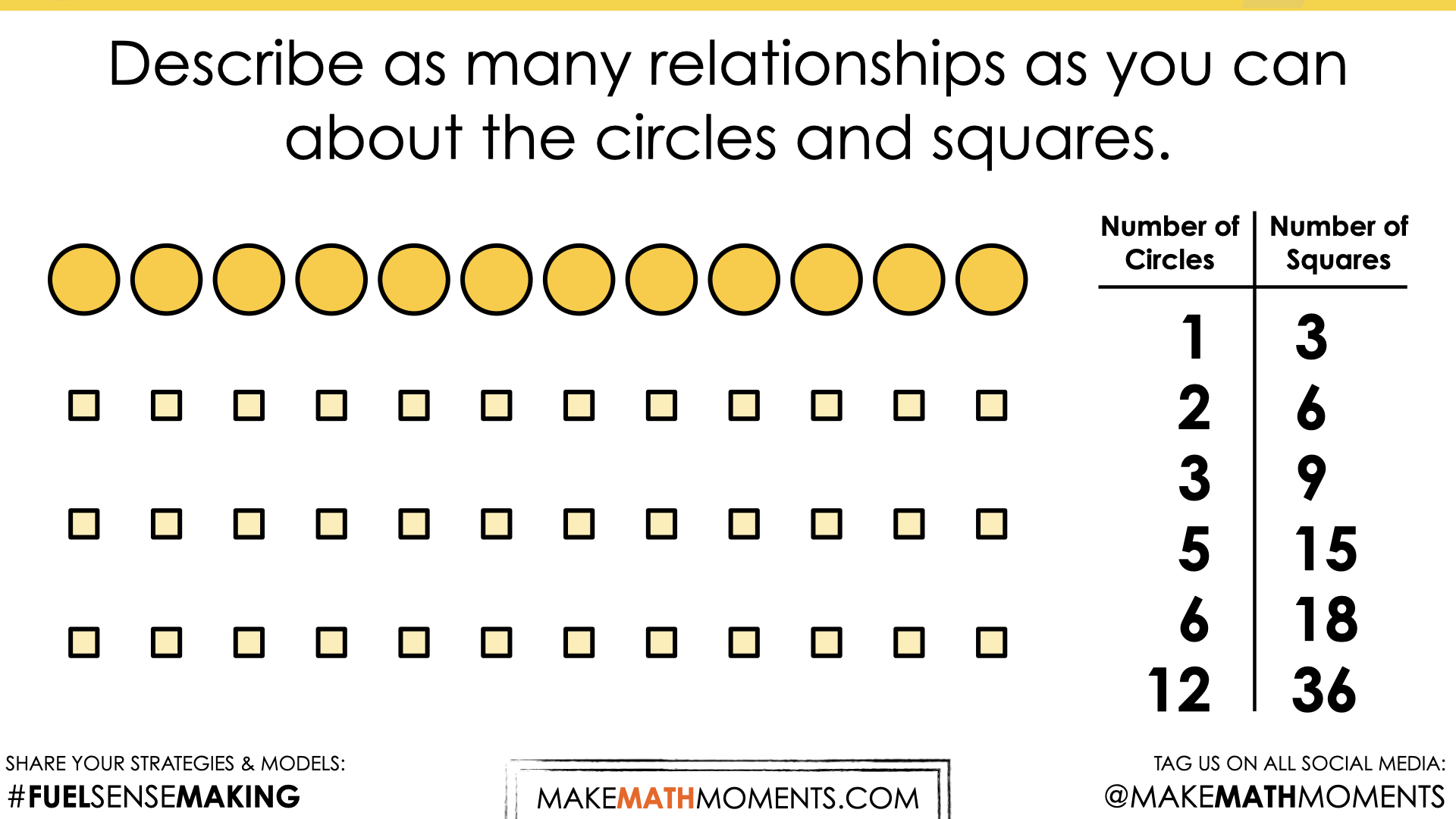
Consider encouraging students to find other equivalent ratios by scaling in tandem (ratio reasoning) or by using the constant of proportionality (rate reasoning) and record their thinking in a ratio table.
Visual Math Talk Prompt #2
Consider utilizing the following visual math talk prompt and be prepared to pause when indicated:
The following prompt will appear on the screen:
Describe as many relationships as you can between the circles and the triangles.

- There are 9 more triangles than circles
- There are 4 times as many triangles as there are circles
- For every circle there are 4 triangles
- \(\frac{4}{5}\) of the shapes are triangles (\(\frac{1}{5}\) of the shapes are circles)
- For every white triangle there are 2 green triangles
Again, consider the language students are using. Is it in absolute terms (i.e.: additive thinking) or in relative terms (i.e.: multiplicative thinking)?
If students are using multiplicative thinking, are they using ratio reasoning (i.e.: comparing squares and triangles as separate quantities) or rate reasoning (i.e.: summarizing the relationship via a single quantity with a compound unit such as 4 squares per circle”)?
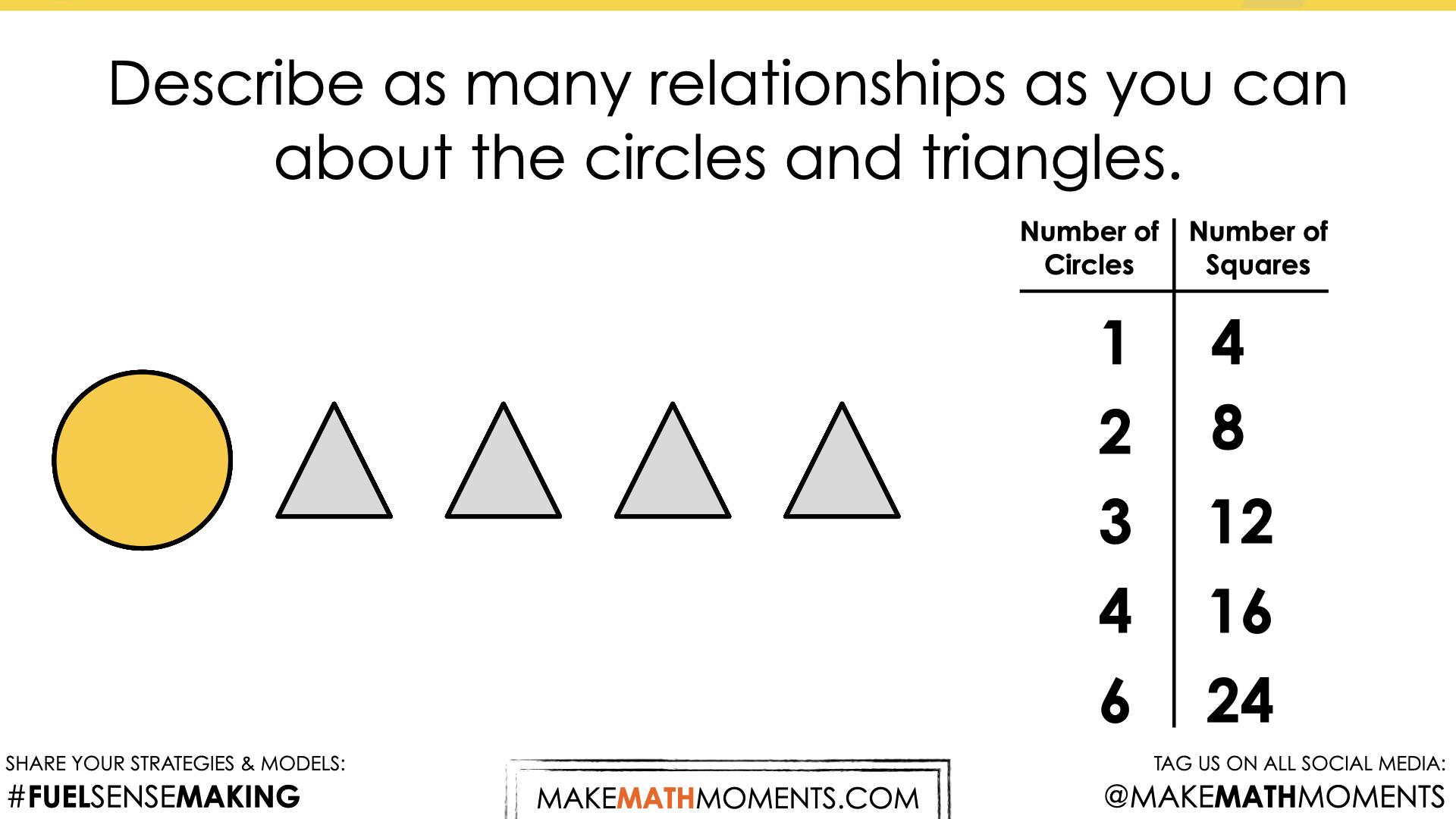
After celebrating the different relationships that students may have shared using various types of reasoning, be sure to highlight again the ratio relationship via a ratio table (or double number line) and ask students to share some equivalent ratios that we can reveal from this relationship. You might also consider highlighting the constant of proportionality (i.e.: finding the rate) by using partitive division to divide the number of circles with the corresponding number of squares or visa versa from multiple rows in the ratio relationship.
Visual Math Talk Prompt #3
Login/Join to access the full Math Talk, teacher guides, downloadable slide decks and printable handouts for this lesson and all problem based units.
Visual Math Talk Prompt #4
While students are practicing, purposeful practice problems, download editable/printable handout.
Become a member to access purposeful practice to display via your projector/TV, download the PDF to upload to your LMS and/or print for students to have a physical copy
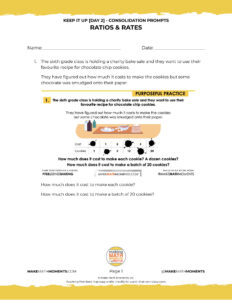
JOIN TO DOWNLOAD
Resources and Downloads
Lesson tip sheet.
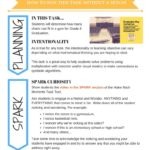
Download the lesson plan in PDF format so you can keep it handy and share with colleagues.
Videos & Images

Keynote Slides

PowerPoint Slides

Printable Handout
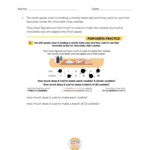
Download/Edit the handout so you can keep it handy and share with colleagues.
Explore The Entire Unit of Study
This Make Math Moments Task was designed to spark curiosity for a multi-day unit of study with built in purposeful practice, and extensions to elicit and emerge mathematical models and strategies.
Click the links at the top of this task to head to the other related lessons created for this unit of study.
1. Bake Sale Cookies
Login/Join to access this full lesson, teacher guides, downloadable slide decks and printable handouts for this lesson and all problem based units.
2. Fuel Efficiency
3. candy colours, 4. more candy colours, 5. daily commute, 6. paint the room.
Get Tasks , Tips & Tools To Your Email!

MAKE MATH MOMENTS ACADEMY
A membership community aimed to accelerate your professional learning journey by supporting mathematics educators as they elevate their pedagogical practice and build their math content knowledge.
Get Started
- Academy Walkthrough
- Get Your Free Classroom / District Report
- Problem Based Lessons & Units
- Curiosity Task Search Engine
- 3-Part Math Lesson Framework
- District Improvement Program
- Listen to Our Podcast
- Join Free For 30-Days
MEMBER AREAS
- Member Dashboard
- Courses & Flagship Programs
- Virtual Summit Replays
- Monthly Q & A Calls
- Member Toolkit Area
- Community Forum Area
- Hire Jon and/or Kyle to Speak
- Search for Tutoring Near Me
- Canadian Wealth Secrets
- MEMBER LOGIN
Save your cart?
Problem Solving and Statistics Practice: Roller Coaster Hill
- Mathematics
High Impact Tutoring Built By Math Experts
Personalized standards-aligned one-on-one math tutoring for schools and districts
Free ready-to-use math resources
Hundreds of free math resources created by experienced math teachers to save time, build engagement and accelerate growth

15 Probability Questions And Practice Problems for Middle and High School: Harder Exam Style Questions Included
Beki Christian
Probability questions and probability problems require students to work out how likely it is that something is to happen. Probabilities can be described using words or numbers. Probabilities range from 0 to 1 and can be written as fractions, decimals or percentages .
Here you’ll find a selection of probability questions of varying difficulty showing the variety you are likely to encounter in middle school and high school, including several harder exam style questions.
What are some real life examples of probability?
The more likely something is to happen, the higher its probability. We think about probabilities all the time.
For example, you may have seen that there is a 20% chance of rain on a certain day or thought about how likely you are to roll a 6 when playing a game, or to win in a raffle when you buy a ticket.

Summer Math Activities
Looking for math games and activities for the final weeks before summer or something to share with your students over the break? Keep math a focus and transition into the next grade with 4 separate worksheets for each grade including relevant topic-based games!
How to calculate probabilities
The probability of something happening is given by:
We can also use the following formula to help us calculate probabilities and solve problems:
- Probability of something not occuring = 1 – probability of if occurring P(not\;A) = 1 - P(A)
- For mutually exclusive events: Probability of event A OR event B occurring = Probability of event A + Probability of event B P(A\;or\;B) = P(A)+P(B)
- For independent events: Probability of event A AND event B occurring = Probability of event A times probability of event B P(A\;and\;B) = P(A) × P(B)
Probability question: A worked example
Question: What is the probability of getting heads three times in a row when flipping a coin?
When flipping a coin, there are two possible outcomes – heads or tails. Each of these options has the same probability of occurring during each flip. The probability of either heads or tails on a single coin flip is ½.
Since there are only two possible outcomes and they have the same probability of occurring, this is called a binomial distribution.
Let’s look at the possible outcomes if we flipped a coin three times.
Let H=heads and T=tails.
The possible outcomes are: HHH, THH, THT, HTT, HHT, HTH, TTH, TTT
Each of these outcomes has a probability of ⅛.
Therefore, the probability of flipping a coin three times in a row and having it land on heads all three times is ⅛.
Middle school probability questions
In middle school, probability questions introduce the idea of the probability scale and the fact that probabilities sum to one. We look at theoretical and experimental probability as well as learning about sample space diagrams and venn diagrams.
6th grade probability questions
1. Which number could be added to this spinner to make it more likely that the spinner will land on an odd number than a prime number?

Currently there are two odd numbers and two prime numbers so the chances of landing on an odd number or a prime number are the same. By adding 3, 5 or 11 you would be adding one prime number and one odd number so the chances would remain equal.
By adding 9 you would be adding an odd number but not a prime number. There would be three odd numbers and two prime numbers so the spinner would be more likely to land on an odd number than a prime number.
2. Ifan rolls a fair dice, with sides labeled A, B, C, D, E and F. What is the probability that the dice lands on a vowel?
A and E are vowels so there are 2 outcomes that are vowels out of 6 outcomes altogether.
Therefore the probability is \frac{2}{6} which can be simplified to \frac{1}{3} .
7th grade probability questions
3. Max tested a coin to see whether it was fair. The table shows the results of his coin toss experiment:
Heads Tails
26 41
What is the relative frequency of the coin landing on heads?
Max tossed the coin 67 times and it landed on heads 26 times.
\text{Relative frequency (experimental probability) } = \frac{\text{number of successful trials}}{\text{total number of trials}} = \frac{26}{67}
4. Grace rolled two dice. She then did something with the two numbers shown. Here is a sample space diagram showing all the possible outcomes:
What did Grace do with the two numbers shown on the dice?
Add them together
Subtract the number on dice 2 from the number on dice 1
Multiply them
Subtract the smaller number from the bigger number
For each pair of numbers, Grace subtracted the smaller number from the bigger number.
For example, if she rolled a 2 and a 5, she did 5 − 2 = 3.
8th grade probability questions
5. Alice has some red balls and some black balls in a bag. Altogether she has 25 balls. Alice picks one ball from the bag. The probability that Alice picks a red ball is x and the probability that Alice picks a black ball is 4x. Work out how many black balls are in the bag.
Since the probability of mutually exclusive events add to 1:
\begin{aligned} x+4x&=1\\\\ 5x&=1\\\\ x&=\frac{1}{5} \end{aligned}
\frac{1}{5} of the balls are red and \frac{4}{5} of the balls are blue.
6. Arthur asked the students in his class whether they like math and whether they like science. He recorded his results in the venn diagram below.
How many students don’t like science?
We need to look at the numbers that are not in the ‘Like science’ circle. In this case it is 9 + 7 = 16.
High school probability questions
In high school, probability questions involve more problem solving to make predictions about the probability of an event. We also learn about probability tree diagrams, which can be used to represent multiple events, and conditional probability.
9th grade probability questions
7. A restaurant offers the following options:
Starter – soup or salad
Main – chicken, fish or vegetarian
Dessert – ice cream or cake
How many possible different combinations of starter, main and dessert are there?
The number of different combinations is 2 × 3 × 2 = 12.
8. There are 18 girls and 12 boys in a class. \frac{2}{9} of the girls and \frac{1}{4} of the boys walk to school. One of the students who walks to school is chosen at random. Find the probability that the student is a boy.
First we need to work out how many students walk to school:
\frac{2}{9} \text{ of } 18 = 4
\frac{1}{4} \text{ of } 12 = 3
7 students walk to school. 4 are girls and 3 are boys. So the probability the student is a boy is \frac{3}{7} .
9. Rachel flips a biased coin. The probability that she gets two heads is 0.16. What is the probability that she gets two tails?
We have been given the probability of getting two heads. We need to calculate the probability of getting a head on each flip.
Let’s call the probability of getting a head p.
The probability p, of getting a head AND getting another head is 0.16.
Therefore to find p:
The probability of getting a head is 0.4 so the probability of getting a tail is 0.6.
The probability of getting two tails is 0.6 × 0.6 = 0.36 .
10th grade probability questions
10. I have a big tub of jelly beans. The probability of picking each different color of jelly bean is shown below:
If I were to pick 60 jelly beans from the tub, how many orange jelly beans would I expect to pick?
First we need to calculate the probability of picking an orange. Probabilities sum to 1 so 1 − (0.2 + 0.15 + 0.1 + 0.3) = 0.25.
The probability of picking an orange is 0.25.
The number of times I would expect to pick an orange jelly bean is 0.25 × 60 = 15 .
11. Dexter runs a game at a fair. To play the game, you must roll a dice and pick a card from a deck of cards.
To win the game you must roll an odd number and pick a picture card. The game can be represented by the tree diagram below.
Dexter charges players $1 to play and gives $3 to any winners. If 260 people play the game, how much profit would Dexter expect to make?
Completing the tree diagram:
Probability of winning is \frac{1}{2} \times \frac{4}{13} = \frac{4}{26}
If 260 play the game, Dexter would receive $260.
The expected number of winners would be \frac{4}{26} \times 260 = 40
Dexter would need to give away 40 × $3 = $120 .
Therefore Dexter’s profit would be $260 − $120 = $140.
12. A fair coin is tossed three times. Work out the probability of getting two heads and one tail.
There are three ways of getting two heads and one tail: HHT, HTH or THH.
The probability of each is \frac{1}{2} \times \frac{1}{2} \times \frac{1}{2} = \frac{1}{8}
Therefore the total probability is \frac{1}{8} +\frac{1}{8} + \frac{1}{8} = \frac{3}{8}
11th/12th grade probability questions
13. 200 people were asked about which athletic event they thought was the most exciting to watch. The results are shown in the table below.
A person is chosen at random. Given that that person chose 100m, what is the probability that the person was female?
Since we know that the person chose 100m, we need to include the people in that column only.
In total 88 people chose 100m so the probability the person was female is \frac{32}{88} .
14. Sam asked 50 people whether they like vegetable pizza or pepperoni pizza.
37 people like vegetable pizza.
25 people like both.
3 people like neither.
Sam picked one of the 50 people at random. Given that the person he chose likes pepperoni pizza, find the probability that they don’t like vegetable pizza.
We need to draw a venn diagram to work this out.
We start by putting the 25 who like both in the middle section. The 37 people who like vegetable pizza includes the 25 who like both, so 12 more people must like vegetable pizza. 3 don’t like either. We have 50 – 12 – 25 – 3 = 10 people left so this is the number that must like only pepperoni.
There are 35 people altogether who like pepperoni pizza. Of these, 10 do not like vegetable pizza. The probability is \frac{10}{35} .
15. There are 12 marbles in a bag. There are n red marbles and the rest are blue marbles. Nico takes 2 marbles from the bag. Write an expression involving n for the probability that Nico takes one red marble and one blue marble.
We need to think about this using a tree diagram. If there are 12 marbles altogether and n are red then 12-n are blue.
To get one red and one blue, Nico could choose red then blue or blue then red so the probability is:
Looking for more middle school and high school probability math questions?
- Ratio questions
- Algebra questions
- Trigonometry questions
- Venn diagram questions
- Long division questions
- Pythagorean theorem questions
Do you have students who need extra support in math? Give your students more opportunities to consolidate learning and practice skills through personalized math tutoring with their own dedicated online math tutor. Each student receives differentiated instruction designed to close their individual learning gaps, and scaffolded learning ensures every student learns at the right pace. Lessons are aligned with your state’s standards and assessments, plus you’ll receive regular reports every step of the way. Personalized one-on-one math tutoring programs are available for: – 2nd grade tutoring – 3rd grade tutoring – 4th grade tutoring – 5th grade tutoring – 6th grade tutoring – 7th grade tutoring – 8th grade tutoring Why not learn more about how it works ?
The content in this article was originally written by secondary teacher Beki Christian and has since been revised and adapted for US schools by elementary math teacher Katie Keeton.
Related articles
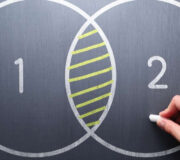
15 Venn Diagram Questions And Practice Problems (Middle & High School): Exam Style Questions Included
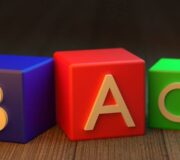
9 Algebra Questions And Practice Problems To Do With Your Middle Schoolers

15 Trigonometry Questions And Practice Problems To Do With High Schoolers

Ratio Questions And Practice Problems: Differentiated Practice Questions Included
Solving Inequalities Questions [FREE]
Downloadable skills and applied questions about solving inequalities.
Includes 10 skills questions, 5 applied questions and an answer key. Print and share with your classes to support their learning.
Privacy Overview
6.5 Solve Proportions and their Applications
Learning objectives.
By the end of this section, you will be able to:
- Use the definition of proportion
- Solve proportions
- Solve applications using proportions
- Write percent equations as proportions
- Translate and solve percent proportions
Be Prepared 6.11
Before you get started, take this readiness quiz.
Simplify: 1 3 4 . 1 3 4 . If you missed this problem, review Example 4.44 .
Be Prepared 6.12
Solve: x 4 = 20 . x 4 = 20 . If you missed this problem, review Example 4.99 .
Be Prepared 6.13
Write as a rate: Sale rode his bike 24 24 miles in 2 2 hours. If you missed this problem, review Example 5.63 .
Use the Definition of Proportion
In the section on Ratios and Rates we saw some ways they are used in our daily lives. When two ratios or rates are equal, the equation relating them is called a proportion .
A proportion is an equation of the form a b = c d , a b = c d , where b ≠ 0 , d ≠ 0 . b ≠ 0 , d ≠ 0 .
The proportion states two ratios or rates are equal. The proportion is read “ a “ a is to b , b , as c c is to d ”. d ”.
The equation 1 2 = 4 8 1 2 = 4 8 is a proportion because the two fractions are equal. The proportion 1 2 = 4 8 1 2 = 4 8 is read “ 1 “ 1 is to 2 2 as 4 4 is to 8 ”. 8 ”.
If we compare quantities with units, we have to be sure we are comparing them in the right order. For example, in the proportion 20 students 1 teacher = 60 students 3 teachers 20 students 1 teacher = 60 students 3 teachers we compare the number of students to the number of teachers. We put students in the numerators and teachers in the denominators.
Example 6.40
Write each sentence as a proportion:
- ⓐ 3 3 is to 7 7 as 15 15 is to 35 . 35 .
- ⓑ 5 5 hits in 8 8 at bats is the same as 30 30 hits in 48 48 at-bats.
- ⓒ $1.50 $1.50 for 6 6 ounces is equivalent to $2.25 $2.25 for 9 9 ounces.
| ⓐ | |
| 3 is to 7 as 15 is to 35. | |
| Write as a proportion. |
| ⓑ | |
| 5 hits in 8 at-bats is the same as 30 hits in 48 at-bats. | |
| Write each fraction to compare hits to at-bats. | |
| Write as a proportion. |
| ⓒ | |
| $1.50 for 6 ounces is equivalent to $2.25 for 9 ounces. | |
| Write each fraction to compare dollars to ounces. | |
| Write as a proportion. |
Try It 6.79
- ⓐ 5 5 is to 9 9 as 20 20 is to 36 . 36 .
- ⓑ 7 7 hits in 11 11 at-bats is the same as 28 28 hits in 44 44 at-bats.
- ⓒ $2.50 $2.50 for 8 8 ounces is equivalent to $3.75 $3.75 for 12 12 ounces.
Try It 6.80
- ⓐ 6 6 is to 7 7 as 36 36 is to 42 . 42 .
- ⓑ 8 8 adults for 36 36 children is the same as 12 12 adults for 54 54 children.
- ⓒ $3.75 $3.75 for 6 6 ounces is equivalent to $2.50 $2.50 for 4 4 ounces.
Look at the proportions 1 2 = 4 8 1 2 = 4 8 and 2 3 = 6 9 . 2 3 = 6 9 . From our work with equivalent fractions we know these equations are true. But how do we know if an equation is a proportion with equivalent fractions if it contains fractions with larger numbers?
To determine if a proportion is true, we find the cross products of each proportion. To find the cross products, we multiply each denominator with the opposite numerator (diagonally across the equal sign). The results are called a cross product because of the cross formed. If, and only if, the given proportion is true, that is, the two sides are equal, then the cross products of a proportion will be equal.
Cross Products of a Proportion
For any proportion of the form a b = c d , a b = c d , where b ≠ 0 , d ≠ 0 , b ≠ 0 , d ≠ 0 , its cross products are equal.
Cross products can be used to test whether a proportion is true. To test whether an equation makes a proportion, we find the cross products. If they are both equal, we have a proportion.
Example 6.41
Determine whether each equation is a proportion:
- ⓐ 4 9 = 12 28 4 9 = 12 28
- ⓑ 17.5 37.5 = 7 15 17.5 37.5 = 7 15
To determine if the equation is a proportion, we find the cross products. If they are equal, the equation is a proportion.
| ⓐ | |
| Find the cross products. | |
Since the cross products are not equal, 28 · 4 ≠ 9 · 12 , 28 · 4 ≠ 9 · 12 , the equation is not a proportion.
| ⓑ | |
| Find the cross products. | |
Since the cross products are equal, 15 · 17.5 = 37.5 · 7 , 15 · 17.5 = 37.5 · 7 , the equation is a proportion.

Try It 6.81
- ⓐ 7 9 = 54 72 7 9 = 54 72
- ⓑ 24.5 45.5 = 7 13 24.5 45.5 = 7 13
Try It 6.82
- ⓐ 8 9 = 56 73 8 9 = 56 73
- ⓑ 28.5 52.5 = 8 15 28.5 52.5 = 8 15
Solve Proportions
To solve a proportion containing a variable, we remember that the proportion is an equation. All of the techniques we have used so far to solve equations still apply. In the next example, we will solve a proportion by multiplying by the Least Common Denominator (LCD) using the Multiplication Property of Equality .
Example 6.42
Solve: x 63 = 4 7 . x 63 = 4 7 .
| To isolate , multiply both sides by the LCD, 63. | ||
| Simplify. | ||
| Divide the common factors. | ||
| Check: To check our answer, we substitute into the original proportion. | ||
| Show common factors. | ||
| Simplify. | ||
Try It 6.83
Solve the proportion: n 84 = 11 12 . n 84 = 11 12 .
Try It 6.84
Solve the proportion: y 96 = 13 12 . y 96 = 13 12 .
When the variable is in a denominator, we’ll use the fact that the cross products of a proportion are equal to solve the proportions.
We can find the cross products of the proportion and then set them equal. Then we solve the resulting equation using our familiar techniques.
Example 6.43
Solve: 144 a = 9 4 . 144 a = 9 4 .
Notice that the variable is in the denominator, so we will solve by finding the cross products and setting them equal.
| Find the cross products and set them equal. | ||
| Simplify. | ||
| Divide both sides by 9. | ||
| Simplify. | ||
| Check your answer. | ||
| Show common factors.. | ||
| Simplify. | ||
Another method to solve this would be to multiply both sides by the LCD, 4 a . 4 a . Try it and verify that you get the same solution.
Try It 6.85
Solve the proportion: 91 b = 7 5 . 91 b = 7 5 .
Try It 6.86
Solve the proportion: 39 c = 13 8 . 39 c = 13 8 .
Example 6.44
Solve: 52 91 = −4 y . 52 91 = −4 y .
| Find the cross products and set them equal. | ||
| Simplify. | ||
| Divide both sides by 52. | ||
| Simplify. | ||
| Check: | ||
| Show common factors. | ||
| Simplify. | ||
Try It 6.87
Solve the proportion: 84 98 = −6 x . 84 98 = −6 x .
Try It 6.88
Solve the proportion: −7 y = 105 135 . −7 y = 105 135 .
Solve Applications Using Proportions
The strategy for solving applications that we have used earlier in this chapter, also works for proportions, since proportions are equations. When we set up the proportion , we must make sure the units are correct—the units in the numerators match and the units in the denominators match.
Example 6.45
When pediatricians prescribe acetaminophen to children, they prescribe 5 5 milliliters (ml) of acetaminophen for every 25 25 pounds of the child’s weight. If Zoe weighs 80 80 pounds, how many milliliters of acetaminophen will her doctor prescribe?
| Identify what you are asked to find. | How many ml of acetaminophen the doctor will prescribe |
| Choose a variable to represent it. | Let ml of acetaminophen. |
| Write a sentence that gives the information to find it. | If 5 ml is prescribed for every 25 pounds, how much will be prescribed for 80 pounds? |
| Translate into a proportion. | |
| Substitute given values—be careful of the units. | |
| Multiply both sides by 80. | |
| Multiply and show common factors. | |
| Simplify. | |
| Check if the answer is reasonable. | |
| Yes. Since 80 is about 3 times 25, the medicine should be about 3 times 5. | |
| Write a complete sentence. | The pediatrician would prescribe 16 ml of acetaminophen to Zoe. |
You could also solve this proportion by setting the cross products equal.
Try It 6.89
Pediatricians prescribe 5 5 milliliters (ml) of acetaminophen for every 25 25 pounds of a child’s weight. How many milliliters of acetaminophen will the doctor prescribe for Emilia, who weighs 60 60 pounds?
Try It 6.90
For every 1 1 kilogram (kg) of a child’s weight, pediatricians prescribe 15 15 milligrams (mg) of a fever reducer. If Isabella weighs 12 12 kg, how many milligrams of the fever reducer will the pediatrician prescribe?
Example 6.46
One brand of microwave popcorn has 120 120 calories per serving. A whole bag of this popcorn has 3.5 3.5 servings. How many calories are in a whole bag of this microwave popcorn?
| Identify what you are asked to find. | How many calories are in a whole bag of microwave popcorn? |
| Choose a variable to represent it. | Let number of calories. |
| Write a sentence that gives the information to find it. | If there are 120 calories per serving, how many calories are in a whole bag with 3.5 servings? |
| Translate into a proportion. | |
| Substitute given values. | |
| Multiply both sides by 3.5. | |
| Multiply. | |
| Check if the answer is reasonable. | |
| Yes. Since 3.5 is between 3 and 4, the total calories should be between 360 (3⋅120) and 480 (4⋅120). | |
| Write a complete sentence. | The whole bag of microwave popcorn has 420 calories. |
Try It 6.91
Marissa loves the Caramel Macchiato at the coffee shop. The 16 16 oz. medium size has 240 240 calories. How many calories will she get if she drinks the large 20 20 oz. size?
Try It 6.92
Yaneli loves Starburst candies, but wants to keep her snacks to 100 100 calories. If the candies have 160 160 calories for 8 8 pieces, how many pieces can she have in her snack?
Example 6.47
Josiah went to Mexico for spring break and changed $325 $325 dollars into Mexican pesos. At that time, the exchange rate had $1 $1 U.S. is equal to 12.54 12.54 Mexican pesos. How many Mexican pesos did he get for his trip?
| Identify what you are asked to find. | How many Mexican pesos did Josiah get? |
| Choose a variable to represent it. | Let number of pesos. |
| Write a sentence that gives the information to find it. | If $1 U.S. is equal to 12.54 Mexican pesos, then $325 is how many pesos? |
| Translate into a proportion. | |
| Substitute given values. | |
| The variable is in the denominator, so find the cross products and set them equal. | |
| Simplify. | |
| Check if the answer is reasonable. | |
| Yes, $100 would be $1,254 pesos. $325 is a little more than 3 times this amount. | |
| Write a complete sentence. | Josiah has 4075.5 pesos for his spring break trip. |
Try It 6.93
Yurianna is going to Europe and wants to change $800 $800 dollars into Euros. At the current exchange rate, $1 $1 US is equal to 0.738 0.738 Euro. How many Euros will she have for her trip?
Try It 6.94
Corey and Nicole are traveling to Japan and need to exchange $600 $600 into Japanese yen. If each dollar is 94.1 94.1 yen, how many yen will they get?
Write Percent Equations As Proportions
Previously, we solved percent equations by applying the properties of equality we have used to solve equations throughout this text. Some people prefer to solve percent equations by using the proportion method. The proportion method for solving percent problems involves a percent proportion. A percent proportion is an equation where a percent is equal to an equivalent ratio.
For example, 60% = 60 100 60% = 60 100 and we can simplify 60 100 = 3 5 . 60 100 = 3 5 . Since the equation 60 100 = 3 5 60 100 = 3 5 shows a percent equal to an equivalent ratio, we call it a percent proportion . Using the vocabulary we used earlier:
Percent Proportion
The amount is to the base as the percent is to 100 . 100 .
If we restate the problem in the words of a proportion, it may be easier to set up the proportion:
We could also say:
First we will practice translating into a percent proportion. Later, we’ll solve the proportion.
Example 6.48
Translate to a proportion. What number is 75% 75% of 90 ? 90 ?
If you look for the word "of", it may help you identify the base.
| Identify the parts of the percent proportion. | |
| Restate as a proportion. | |
| Set up the proportion. Let . |
Try It 6.95
Translate to a proportion: What number is 60% 60% of 105 ? 105 ?
Try It 6.96
Translate to a proportion: What number is 40% 40% of 85 ? 85 ?
Example 6.49
Translate to a proportion. 19 19 is 25% 25% of what number?
| Identify the parts of the percent proportion. | |
| Restate as a proportion. | |
| Set up the proportion. Let . |
Try It 6.97
Translate to a proportion: 36 36 is 25% 25% of what number?
Try It 6.98
Translate to a proportion: 27 27 is 36% 36% of what number?
Example 6.50
Translate to a proportion. What percent of 27 27 is 9 ? 9 ?
| Identify the parts of the percent proportion. | |
| Restate as a proportion. | |
| Set up the proportion. Let . |
Try It 6.99
Translate to a proportion: What percent of 52 52 is 39 ? 39 ?
Try It 6.100
Translate to a proportion: What percent of 92 92 is 23 ? 23 ?
Translate and Solve Percent Proportions
Now that we have written percent equations as proportions, we are ready to solve the equations.
Example 6.51
Translate and solve using proportions: What number is 45% 45% of 80 ? 80 ?
| Identify the parts of the percent proportion. | |
| Restate as a proportion. | |
| Set up the proportion. Let number. | |
| Find the cross products and set them equal. | |
| Simplify. | |
| Divide both sides by 100. | |
| Simplify. | |
| Check if the answer is reasonable. | |
| Yes. 45 is a little less than half of 100 and 36 is a little less than half 80. | |
| Write a complete sentence that answers the question. | 36 is 45% of 80. |
Try It 6.101
Translate and solve using proportions: What number is 65% 65% of 40 ? 40 ?
Try It 6.102
Translate and solve using proportions: What number is 85% 85% of 40 ? 40 ?
In the next example, the percent is more than 100 , 100 , which is more than one whole. So the unknown number will be more than the base.
Example 6.52
Translate and solve using proportions: 125% 125% of 25 25 is what number?
| Identify the parts of the percent proportion. | |
| Restate as a proportion. | |
| Set up the proportion. Let number. | |
| Find the cross products and set them equal. | |
| Simplify. | |
| Divide both sides by 100. | |
| Simplify. | |
| Check if the answer is reasonable. | |
| Yes. 125 is more than 100 and 31.25 is more than 25. | |
| Write a complete sentence that answers the question. | 125% of 25 is 31.25. |
Try It 6.103
Translate and solve using proportions: 125% 125% of 64 64 is what number?
Try It 6.104
Translate and solve using proportions: 175% 175% of 84 84 is what number?
Percents with decimals and money are also used in proportions.
Example 6.53
Translate and solve: 6.5% 6.5% of what number is $1.56 ? $1.56 ?
| Identify the parts of the percent proportion. | |
| Restate as a proportion. | |
| Set up the proportion. Let number. | |
| Find the cross products and set them equal. | |
| Simplify. | |
| Divide both sides by 6.5 to isolate the variable. | |
| Simplify. | |
| Check if the answer is reasonable. | |
| Yes. 6.5% is a small amount and $1.56 is much less than $24. | |
| Write a complete sentence that answers the question. | 6.5% of $24 is $1.56. |
Try It 6.105
Translate and solve using proportions: 8.5% 8.5% of what number is $3.23 ? $3.23 ?
Try It 6.106
Translate and solve using proportions: 7.25% 7.25% of what number is $4.64 ? $4.64 ?
Example 6.54
Translate and solve using proportions: What percent of 72 72 is 9 ? 9 ?
| Identify the parts of the percent proportion. | |
| Restate as a proportion. | |
| Set up the proportion. Let number. | |
| Find the cross products and set them equal. | |
| Simplify. | |
| Divide both sides by 72. | |
| Simplify. | |
| Check if the answer is reasonable. | |
| Yes. 9 is of 72 and is 12.5%. | |
| Write a complete sentence that answers the question. | 12.5% of 72 is 9. |
Try It 6.107
Translate and solve using proportions: What percent of 72 72 is 27 ? 27 ?
Try It 6.108
Translate and solve using proportions: What percent of 92 92 is 23 ? 23 ?
Section 6.5 Exercises
Practice makes perfect.
In the following exercises, write each sentence as a proportion.
4 4 is to 15 15 as 36 36 is to 135 . 135 .
7 7 is to 9 9 as 35 35 is to 45 . 45 .
12 12 is to 5 5 as 96 96 is to 40 . 40 .
15 15 is to 8 8 as 75 75 is to 40 . 40 .
5 5 wins in 7 7 games is the same as 115 115 wins in 161 161 games.
4 4 wins in 9 9 games is the same as 36 36 wins in 81 81 games.
8 8 campers to 1 1 counselor is the same as 48 48 campers to 6 6 counselors.
6 6 campers to 1 1 counselor is the same as 48 48 campers to 8 8 counselors.
$9.36 $9.36 for 18 18 ounces is the same as $2.60 $2.60 for 5 5 ounces.
$3.92 $3.92 for 8 8 ounces is the same as $1.47 $1.47 for 3 3 ounces.
$18.04 $18.04 for 11 11 pounds is the same as $4.92 $4.92 for 3 3 pounds.
$12.42 $12.42 for 27 27 pounds is the same as $5.52 $5.52 for 12 12 pounds.
In the following exercises, determine whether each equation is a proportion.
7 15 = 56 120 7 15 = 56 120
5 12 = 45 108 5 12 = 45 108
11 6 = 21 16 11 6 = 21 16
9 4 = 39 34 9 4 = 39 34
12 18 = 4.99 7.56 12 18 = 4.99 7.56
9 16 = 2.16 3.89 9 16 = 2.16 3.89
13.5 8.5 = 31.05 19.55 13.5 8.5 = 31.05 19.55
10.1 8.4 = 3.03 2.52 10.1 8.4 = 3.03 2.52
In the following exercises, solve each proportion.
x 56 = 7 8 x 56 = 7 8
n 91 = 8 13 n 91 = 8 13
49 63 = z 9 49 63 = z 9
56 72 = y 9 56 72 = y 9
5 a = 65 117 5 a = 65 117
4 b = 64 144 4 b = 64 144
98 154 = −7 p 98 154 = −7 p
72 156 = −6 q 72 156 = −6 q
a −8 = −42 48 a −8 = −42 48
b −7 = −30 42 b −7 = −30 42
2.6 3.9 = c 3 2.6 3.9 = c 3
2.7 3.6 = d 4 2.7 3.6 = d 4
2.7 j = 0.9 0.2 2.7 j = 0.9 0.2
2.8 k = 2.1 1.5 2.8 k = 2.1 1.5
1 2 1 = m 8 1 2 1 = m 8
1 3 3 = 9 n 1 3 3 = 9 n
In the following exercises, solve the proportion problem.
Pediatricians prescribe 5 5 milliliters (ml) of acetaminophen for every 25 25 pounds of a child’s weight. How many milliliters of acetaminophen will the doctor prescribe for Jocelyn, who weighs 45 45 pounds?
Brianna, who weighs 6 6 kg, just received her shots and needs a pain killer. The pain killer is prescribed for children at 15 15 milligrams (mg) for every 1 1 kilogram (kg) of the child’s weight. How many milligrams will the doctor prescribe?
At the gym, Carol takes her pulse for 10 10 sec and counts 19 19 beats. How many beats per minute is this? Has Carol met her target heart rate of 140 140 beats per minute?
Kevin wants to keep his heart rate at 160 160 beats per minute while training. During his workout he counts 27 27 beats in 10 10 seconds. How many beats per minute is this? Has Kevin met his target heart rate?
A new energy drink advertises 106 106 calories for 8 8 ounces. How many calories are in 12 12 ounces of the drink?
One 12 12 ounce can of soda has 150 150 calories. If Josiah drinks the big 32 32 ounce size from the local mini-mart, how many calories does he get?
Karen eats 1 2 1 2 cup of oatmeal that counts for 2 2 points on her weight loss program. Her husband, Joe, can have 3 3 points of oatmeal for breakfast. How much oatmeal can he have?
An oatmeal cookie recipe calls for 1 2 1 2 cup of butter to make 4 4 dozen cookies. Hilda needs to make 10 10 dozen cookies for the bake sale. How many cups of butter will she need?
Janice is traveling to Canada and will change $250 $250 US dollars into Canadian dollars. At the current exchange rate, $1 $1 US is equal to $1.01 $1.01 Canadian. How many Canadian dollars will she get for her trip?
Todd is traveling to Mexico and needs to exchange $450 $450 into Mexican pesos. If each dollar is worth 12.29 12.29 pesos, how many pesos will he get for his trip?
Steve changed $600 $600 into 480 480 Euros. How many Euros did he receive per US dollar?
Martha changed $350 $350 US into 385 385 Australian dollars. How many Australian dollars did she receive per US dollar?
At the laundromat, Lucy changed $12.00 $12.00 into quarters. How many quarters did she get?
When she arrived at a casino, Gerty changed $20 $20 into nickels. How many nickels did she get?
Jesse’s car gets 30 30 miles per gallon of gas. If Las Vegas is 285 285 miles away, how many gallons of gas are needed to get there and then home? If gas is $3.09 $3.09 per gallon, what is the total cost of the gas for the trip?
Danny wants to drive to Phoenix to see his grandfather. Phoenix is 370 370 miles from Danny’s home and his car gets 18.5 18.5 miles per gallon. How many gallons of gas will Danny need to get to and from Phoenix? If gas is $3.19 $3.19 per gallon, what is the total cost for the gas to drive to see his grandfather?
Hugh leaves early one morning to drive from his home in Chicago to go to Mount Rushmore, 812 812 miles away. After 3 3 hours, he has gone 190 190 miles. At that rate, how long will the whole drive take?
Kelly leaves her home in Seattle to drive to Spokane, a distance of 280 280 miles. After 2 2 hours, she has gone 152 152 miles. At that rate, how long will the whole drive take?
Phil wants to fertilize his lawn. Each bag of fertilizer covers about 4,000 4,000 square feet of lawn. Phil’s lawn is approximately 13,500 13,500 square feet. How many bags of fertilizer will he have to buy?
April wants to paint the exterior of her house. One gallon of paint covers about 350 350 square feet, and the exterior of the house measures approximately 2000 2000 square feet. How many gallons of paint will she have to buy?
Write Percent Equations as Proportions
In the following exercises, translate to a proportion.
What number is 35% 35% of 250 ? 250 ?
What number is 75% 75% of 920 ? 920 ?
What number is 110% 110% of 47 ? 47 ?
What number is 150% 150% of 64 ? 64 ?
45 45 is 30% 30% of what number?
25 25 is 80% 80% of what number?
90 90 is 150% 150% of what number?
77 77 is 110% 110% of what number?
What percent of 85 85 is 17 ? 17 ?
What percent of 92 92 is 46 ? 46 ?
What percent of 260 260 is 340 ? 340 ?
What percent of 180 180 is 220 ? 220 ?
In the following exercises, translate and solve using proportions.
What number is 65% 65% of 180 ? 180 ?
What number is 55% 55% of 300 ? 300 ?
18% 18% of 92 92 is what number?
22% 22% of 74 74 is what number?
175% 175% of 26 26 is what number?
250% 250% of 61 61 is what number?
What is 300% 300% of 488 ? 488 ?
What is 500% 500% of 315 ? 315 ?
17% 17% of what number is $7.65 ? $7.65 ?
19% 19% of what number is $6.46 ? $6.46 ?
$13.53 $13.53 is 8.25% 8.25% of what number?
$18.12 $18.12 is 7.55% 7.55% of what number?
What percent of 56 56 is 14 ? 14 ?
What percent of 80 80 is 28 ? 28 ?
What percent of 96 96 is 12 ? 12 ?
What percent of 120 120 is 27 ? 27 ?
Everyday Math
Mixing a concentrate Sam bought a large bottle of concentrated cleaning solution at the warehouse store. He must mix the concentrate with water to make a solution for washing his windows. The directions tell him to mix 3 3 ounces of concentrate with 5 5 ounces of water. If he puts 12 12 ounces of concentrate in a bucket, how many ounces of water should he add? How many ounces of the solution will he have altogether?
Mixing a concentrate Travis is going to wash his car. The directions on the bottle of car wash concentrate say to mix 2 2 ounces of concentrate with 15 15 ounces of water. If Travis puts 6 6 ounces of concentrate in a bucket, how much water must he mix with the concentrate?
Writing Exercises
To solve “what number is 45% 45% of 350 ” 350 ” do you prefer to use an equation like you did in the section on Decimal Operations or a proportion like you did in this section? Explain your reason.
To solve “what percent of 125 125 is 25 ” 25 ” do you prefer to use an equation like you did in the section on Decimal Operations or a proportion like you did in this section? Explain your reason.
ⓐ After completing the exercises, use this checklist to evaluate your mastery of the objectives of this section.
ⓑ Overall, after looking at the checklist, do you think you are well-prepared for the next Chapter? Why or why not?
As an Amazon Associate we earn from qualifying purchases.
This book may not be used in the training of large language models or otherwise be ingested into large language models or generative AI offerings without OpenStax's permission.
Want to cite, share, or modify this book? This book uses the Creative Commons Attribution License and you must attribute OpenStax.
Access for free at https://openstax.org/books/prealgebra-2e/pages/1-introduction
- Authors: Lynn Marecek, MaryAnne Anthony-Smith, Andrea Honeycutt Mathis
- Publisher/website: OpenStax
- Book title: Prealgebra 2e
- Publication date: Mar 11, 2020
- Location: Houston, Texas
- Book URL: https://openstax.org/books/prealgebra-2e/pages/1-introduction
- Section URL: https://openstax.org/books/prealgebra-2e/pages/6-5-solve-proportions-and-their-applications
© Jan 23, 2024 OpenStax. Textbook content produced by OpenStax is licensed under a Creative Commons Attribution License . The OpenStax name, OpenStax logo, OpenStax book covers, OpenStax CNX name, and OpenStax CNX logo are not subject to the Creative Commons license and may not be reproduced without the prior and express written consent of Rice University.
A free service from Mattecentrum
Solving problems with percentages
- Price difference I
- Price difference II
- How many students?
To solve problems with percent we use the percent proportion shown in "Proportions and percent".
$$\frac{a}{b}=\frac{x}{100}$$
$$\frac{a}{{\color{red} {b}}}\cdot {\color{red} {b}}=\frac{x}{100}\cdot b$$
$$a=\frac{x}{100}\cdot b$$
x/100 is called the rate.
$$a=r\cdot b\Rightarrow Percent=Rate\cdot Base$$
Where the base is the original value and the percentage is the new value.
47% of the students in a class of 34 students has glasses or contacts. How many students in the class have either glasses or contacts?
$$a=r\cdot b$$
$$47\%=0.47a$$
$$=0.47\cdot 34$$
$$a=15.98\approx 16$$
16 of the students wear either glasses or contacts.
We often get reports about how much something has increased or decreased as a percent of change. The percent of change tells us how much something has changed in comparison to the original number. There are two different methods that we can use to find the percent of change.
The Mathplanet school has increased its student body from 150 students to 240 from last year. How big is the increase in percent?
We begin by subtracting the smaller number (the old value) from the greater number (the new value) to find the amount of change.
$$240-150=90$$
Then we find out how many percent this change corresponds to when compared to the original number of students
$$90=r\cdot 150$$
$$\frac{90}{150}=r$$
$$0.6=r= 60\%$$
We begin by finding the ratio between the old value (the original value) and the new value
$$percent\:of\:change=\frac{new\:value}{old\:value}=\frac{240}{150}=1.6$$
As you might remember 100% = 1. Since we have a percent of change that is bigger than 1 we know that we have an increase. To find out how big of an increase we've got we subtract 1 from 1.6.
$$1.6-1=0.6$$
$$0.6=60\%$$
As you can see both methods gave us the same answer which is that the student body has increased by 60%
Video lessons
A skirt cost $35 regulary in a shop. At a sale the price of the skirtreduces with 30%. How much will the skirt cost after the discount?
Solve "54 is 25% of what number?"
- Pre-Algebra
- The mean, the median and the mode
- Stem-and-Leaf Plots and Box-and-Whiskers Plot
- Calculating the outcome
- Combinations and permutations
- Finding the odds
- Probability of events
- Geometry – fundamental statements
- Circle graphs
- Angles and parallel lines
- Quadrilaterals, polygons and transformations
- Measure areas
- Pyramids, prisms, cylinders and cones
- Square roots and real numbers
- The Pythagorean Theorem
- Trigonometry
- Algebra 1 Overview
- Algebra 2 Overview
- Geometry Overview
- SAT Overview
- ACT Overview





IMAGES
VIDEO
COMMENTS
Category: Problem Solving and Data Analysis / Statistics and Probability Strategic Advice: Start by completing the rest of the table. Use the information you found in the previous question. Getting to the Answer: Because there are 402 hybrids in total, there are 402 - 132 = 270 orange trees that are hybrids, which
Problem Solving, Statistics, Probability, Proportions, Percents Practice 1. 2. 3. Calculator . 4. Calculator ... The number of leaves left on the tree is reduced by about 92% each day. ... Day 2 Problems, Statistics, Probability, Proportions, Percents Practice Author: amtupaj
84, so the plant ended the day at 112 + 84 = 196, which is 196 - 100 = 96 more than it started the day with. To find the percent change, use the formula Percent change = amount of change to get~ - 0.96 . 96%. original amount 100 Problem Solving, Statistics, Probability, Proportions, Percents Notes Solutions 1. Calculator 2. Calculator
Finding probabilities with sample proportions. A local agricultural cooperative claims that 55 % of about 60,000 adults in a county believe that gardening should be part of the school curriculum. However, when you take a simple random sample of 300 of the adults in the county, only 50 % say that they believe that gardening should be part of the ...
What number is 40% of 10? 4. 3 is 60% of what number? 5. 11 is 25% of what number? 44. What number is 75% of 8? 6. Using proportions to solve percent problems Learn with flashcards, games, and more — for free.
Here is how it works: Assign students a 4-step problem to work on in pairs. Monitor the room to support student learning. As each pair finishes, send them to the white board to write up 1 of the steps STATE, PLAN, DO, or CONCLUDE. The first two pairs should handle the PLAN and the DO because they take the longest to write up.
This problem requires us to find the probability that p1 is less than p 2. This is equivalent to finding the probability that p 1 - p 2 is less than zero. To find this probability, we need to transform the random variable (p 1 - p 2) into a z-score. That transformation appears below. z p 1 - p 2 = (x - μ p 1 - p 2) / σ d = (0 - 0.05)/0.0706 ...
Percent Problems Date_____ Period____ Solve each problem. Round to the nearest tenth or tenth of a percent. 1) What percent of 29 is 3? ... Solve each problem. Round to the nearest tenth or tenth of a percent. 1) What percent of 29 is 3? 10.3% 2) What percent of 33.5 is 21? 62.7%
Practice Questions. Previous: Direct and Inverse Proportion Practice Questions. Next: Reverse Percentages Practice Questions. The Corbettmaths Practice Questions on Probability.
The Corbettmaths Practice Questions on finding a percentage of an amount. Welcome; Videos and Worksheets; Primary; 5-a-day. 5-a-day GCSE 9-1; 5-a-day Primary; 5-a-day Further Maths; More. Further Maths; GCSE Revision ... Click here for Questions Click here for Answers. Practice Questions. Previous: Foundation Solving Quadratics. Next: Ratio ...
Courses on Khan Academy are always 100% free. Start practicing—and saving your progress—now: https://www.khanacademy.org/math/ap-statistics/sampling-distrib...
Visual Math Talk Prompts and Purposeful Practice Problems Worksheet related to ratios and solving proportions by revealing equivalent ratios through the use of scaling. TASKS; ... The purpose of Day 2 activities is to reinforce concepts from Day 1. Students will engage in a visual number talk that will encourage them to consider different ways ...
Mathematics document from University of California, Davis, 5 pages, Problem Solving, Statistics, Probability, Proportions, Percents Practice Solutions 1. -· I 90 .-·- - • • • I 80 ._ f - - 70 60 so - 40 - 30 20 10 -. - •I >- l f- I. 1 l 0 • • f- 20 40 60 80 100 Distance (in feet) 120 The figure above shows part of the pat
1. rolling a number less than 6 on a number cube labeled 1 through 6. 2. flipping a coin and getting heads. 3. spinning a number less than 3 on a spinner with 8 equal sections marked 1 through 8. 4. drawing a red or blue marble from a bag of red marbles and blue marbles. 5. rolling a number greater than 6 on a number. _________________ A.
8th grade probability questions. 5. Alice has some red balls and some black balls in a bag. Altogether she has 25 balls. Alice picks one ball from the bag. The probability that Alice picks a red ball is x and the probability that Alice picks a black ball is 4x. Work out how many black balls are in the bag. 6 6. 100 100.
Some people prefer to solve percent equations by using the proportion method. The proportion method for solving percent problems involves a percent proportion. A percent proportion is an equation where a percent is equal to an equivalent ratio. For example, 60% = 60 100 60% = 60 100 and we can simplify 60 100 = 3 5. 60 100 = 3 5.
Your answer should be. an integer, like 6. a simplified properfraction, like 3/5. a simplified improperfraction, like 7/4. a mixed number, like 1 3/4. an exactdecimal, like 0.75. a multiple of pi, like 12 pi or 2/3 pi. Related content.
To solve problems with percent we use the percent proportion shown in "Proportions and percent". a b = x 100 a b = x 100. a b ⋅b = x 100 ⋅ b a b ⋅ b = x 100 ⋅ b. a = x 100 ⋅ b a = x 100 ⋅ b. x/100 is called the rate. a = r ⋅ b ⇒ Percent = Rate ⋅ Base a = r ⋅ b ⇒ P e r c e n t = R a t e ⋅ B a s e. Where the base is the ...
Solve each problem by setting up a proportion and or a product of rates. Each answer will give you a letter to the password when you find it in the DECODER GRID. A correct password entered at the bottom will get you to the TREASURE ROOM. Letter 1.) is a woman with a sweet dream. She wants to create the best donuts in the industry. She just ...
What is the net percent increase of this company's reliance on solar panels during that day? G) 750/0 C) 105% 0 165% Mercury is a naturally occurring metal that can be harmful to humans. The current recommendation is for humans to take in no more than 0.1 microgram for every kilogram of their weight per day.
One of the easiest ways to change a ratio to a percent is by using a proportion. Example: Express three out of five as a percent: You may have learned the following: 100 % of is Is over of equals percent over 100. This is the useful for very simple problems involving percents: Examples: Use the Percent Proportion to Solve: 1. What percent is 12 ...
a simplified improperfraction, like 7/4. a mixed number, like 1 3/4. an exactdecimal, like 0.75. a multiple of pi, like 12 pi or 2/3 pi. Related content. Video 7 minutes 20 seconds7:20. Worked example: Solving proportions. Video 5 minutes 48 seconds5:48. Proportion word problem: cookies.
To find out what percent of the 25 asked said they like pizza, divide the numerator by the denominator, then multiply by 100. 20 25 =20 ÷25 = 0.80 =80% 20 25 = 20 ÷ 25 = 0.80 = 80 %. Percent literally means "per 100," or "parts per hundred.". When we write 40%, this is equivalent to the fraction 40 100 40 100 or the decimal 0.40.
Section 2: Free-response (50% of the exam score) This section lasts 90 minutes and includes six questions in various formats. Here, you will need to show your ability to explain concepts, justify your answers with data and statistical reasoning, and solve problems through written responses. The six questions can be broken down into two parts: